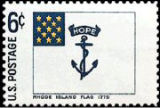![]()
Postal History Introduction
Stampless
Covers
1846
to 1900 Issues
1901-1950
Issues
1951-2003
Issues
Cancels
&
Miscellaneous
Postal
Stationery
Post
Cards
Air
Mail
First
Day &
Event Covers
Parcel Post/Special Delivery
Registered & Official Mail
Commercial & Advertising
Revenue & Postage Due
Wildlife & Game Issues
Complete List of RI Issues
Rhode Island Stamp
Issues - 1775 Historic Flag
The First
Rhode Island Island (African American) Regiment
 |
Historic Flags Issue
- 1775 Rhode Island Flag |
|
During the early stages of the
Revolutionary war, General Washington was against using African Americans and
in November 1775 he issued an order barring black enlistment in the
Continental Army. The British were under no such delusions and Lord Dunmore of
Virginia issued a proclamation offering freedom to any indentured servants or
slaves who volunteered their service; within a month over 300 had volunteered.
General Washington fearing that the discharged African Americans from the Continental
Army would join the British began urging congress to enroll free Blacks.
In addition most states found it difficult to meet
the recruiting quotas set by the Continental Congress. Rhode Island had been ordered to supply an additional regiment and most of their available men were already involved in fighting the British within their own borders. General James Varnum, in command of the remnants of the two Rhode Island regiments already in service with the Continental Army advised Washington to merge the two regiments and send the officers of the 1st to Rhode Island to recruit African Americans for a new regiment. Washington agreed and the legislation was quickly passed by the Rhode Island General Assembly on February 23, 1778. It stated that each individual slave enrolled in the regiment "upon his passing muster, he is absolutely made free, and entitled to all the wages, bounties, and encouragements given by Congress to any soldier enlisting." Provision was also made by the State Legislature to provide compensation to slave owners of up to $400.00. The slaves were purchased by the state and after service in the army for the duration of the war or until discharged would be freed. Colonel Christopher Greene (a distant relative of Nathaniel Greene), along with his two senior officers; Lt. Colonel Jeremiah Olney and Major Sam Ward were chosen by General Washington to lead the 1st Rhode Island, the first all-black American regiment. During the Battle of Rhode Island in
August 1778, Hessian troops directed The Americans lost the Battle of
Rhode Island, however, the British lost 5 times as many troops. The
1st Rhode Island held the line for over four
hours against the British assault and it was largely due to their efforts that
the American Army was able to escape. General Lafayette
called it, “ During the spring of 1781 the 1st Rhode Island was stationed north of Manhattan along the Croton River. On May 14th a raiding party of Tories surprised the Rhode Islanders at two points. Both Greene and Flagg were killed and Lt. Colonel Jeremiah Olney assumed command. William Cooper Nell in describing the The 1st Rhode Island was demobilized at Saratoga in June of 1783 after having fought valiantly as a part of the Continental Army for over 5 years. The troops were left to find their own way home and in later years often had to resist efforts to re-enslave them. Colonel Olney assisted his former troops in their efforts to remain free and also supported their claims for pensions from the U.S. government. |
|
Sources:
American
Patriots by Gail Buckley
Gretchen
A. Adams - University of New Hampshire
American
Revolution.org
The
African American Registry
![]()
RI Historical Society
The Post Offices
Home Page
RI
Postal History Society
RI Philatelic Society
Recently Added Pages
Philatelic Primer
Rhode Island Around the World
Rhode Island
Town Postmarks
Other Websites of Interest